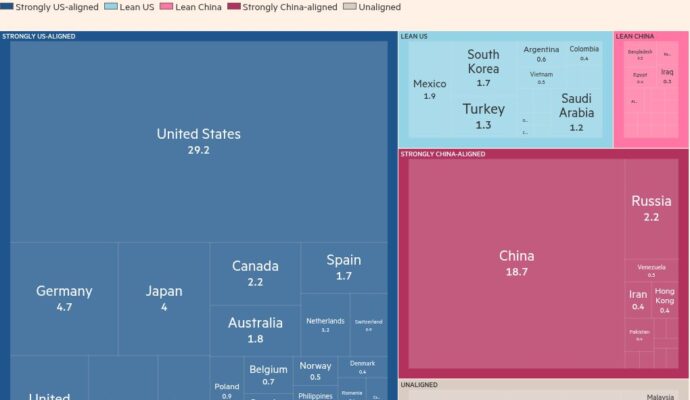Stay informed with free updates
Simply sign up to the Artificial intelligence myFT Digest — delivered directly to your inbox.
China has overtaken the US in the global market for “open” artificial intelligence models, gaining a crucial edge over how the powerful technology is used around the world.
A study by the Massachusetts Institute of Technology and open-source AI start-up Hugging Face found that the total share of downloads of new Chinese-made open models rose to 17 per cent in the past year.
The figure surpasses the 15.8 per cent share of downloads from American developers such as Google, Meta and OpenAI — the first time Chinese groups have beaten their American counterparts.
Open models — which are free to download, modify and integrate by developers — make it easier for start-ups to create products and researchers to improve them. Widespread adoption will confer outsized influence over AI’s future.
China’s push to release open models comes in stark contrast to the “closed” approach of most of the biggest US tech companies.
OpenAI, Google and Anthropic have preferred to maintain full control of their most advanced technology, profiting from them through customer subscriptions or enterprise deals.
By contrast, Chinese groups — which have been cut off from advanced AI chips made by Nvidia — have been encouraged by Beijing officials to offer wider access to their models.
“In China, open source has been sort of a more mainstream trend than in the US,” said Wendy Chang, senior analyst at think-tank Mercator Institute for China Studies. “US companies have chosen not to play that way. They’re making money on these high valuations. They don’t want to open source their secrets.”
DeepSeek and Alibaba’s Qwen models make up the vast majority of downloads of Chinese models, according to MIT and Hugging Face’s data.
DeepSeek shocked Silicon Valley when it introduced its powerful AI reasoning model R1, which was on par with US competitors despite using a fraction of the cost and computing power.
The release raised questions about whether better resourced US AI labs could defend their competitive edge. It also raised doubts over the billions of dollars being spent to build the data centres needed to operate powerful models.
The Trump administration, which is anxious to win the AI race against China, has sought to convince US groups to invest in open-source models with “American values” in its AI Action Plan.
In August, OpenAI introduced its first “open weight” models — which are free to access, but provide less comprehensive information than “open source” models that supply the code and training data required to train a model from scratch.
Meta, whose family of Llama models was the gold standard of open-weight AI development for years, has shifted its strategy by investing more into developing powerful closed models, as it races against the likes of OpenAI, Anthropic and Google to develop “superintelligence”.
Chinese companies such as DeepSeek and Alibaba Cloud have introduced a “paradigm shifting” way of releasing models, said Shayne Longpre, a researcher at MIT who was part of the study.
He said Chinese companies were shipping models on a weekly or biweekly basis, with many different variations that users can choose from, rather than releasing a series of models every six months or year like US labs.
Other experts said that while China might be restrained in computing power, thanks to US export controls on powerful chips, the country has a wealth of homegrown researchers.
This has allowed the country’s AI groups to be more creative in their approach to model development, using techniques such as distillation to create smaller yet powerful models. The country’s AI labs have also leaned in heavily into developing AI video-generation models.
The popularity of Chinese open models is already influencing the information people receive. Researchers have shown that Chinese models have clear Chinese Communist party biases and ideologies, and generally decline to generate information on controversial topics such as Taiwan or the Tiananmen Square massacre.
Meanwhile, US labs are much more focused on progressing state-of-the-art “frontier” models, with OpenAI and Google DeepMind aiming to build artificial general intelligence, or AI systems that exceed human capabilities.
The US has far fewer big independent players in open source development than China. Its most recent contribution has been by the Seattle-based Allen Institute for AI, which launched its Olmo 3, a fully open source model, in November.
Janet Egan, senior fellow and deputy director at the Center for a New American Security, a think-tank, said: “It should be of concern to the US that China is making great strides in the open . . . model domain.”
Additional reporting by Eleanor Olcott and Ryan McMorrow in Beijing. Data visualisations by Martin Stabe





